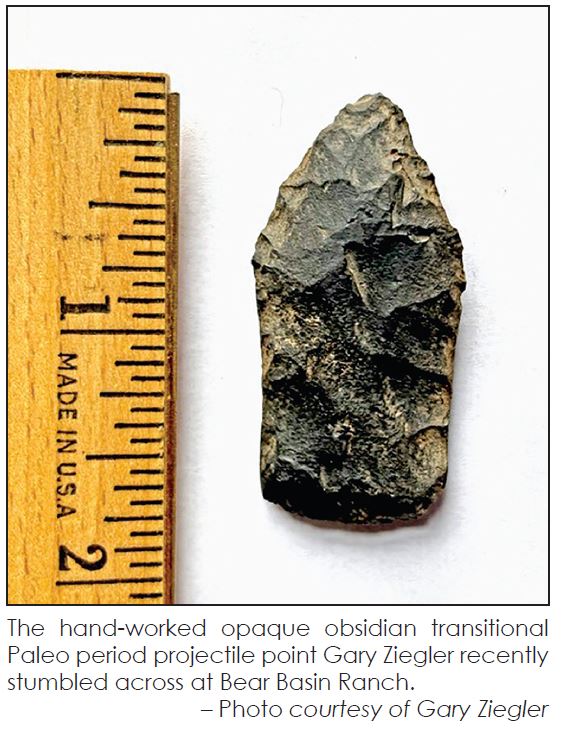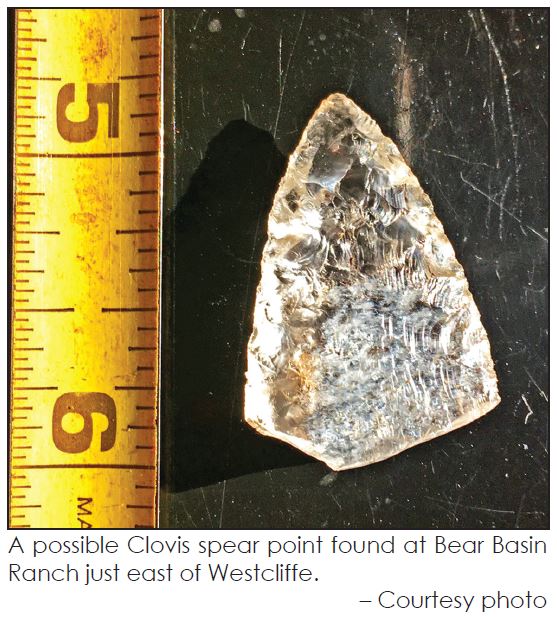Ziegler and Finger have made several native discoveries on their ranch east of town including a possible Clovis crystal spear point
Originally published on November 5, 2020
Sometimes the curating of local history is actually a matter of caringly tending to the space in which you live, particularly, as is the case at Bear Basin Ranch, if that space is steeped in deep history, legacy, and the artifacts of those who have come before. When Gary Ziegler acquired the initial acreage and buildings that are the core of the present day ranch half a century ago, there was perhaps an inkling of where his trajectory may have been headed, but hardly a solid plan for the manner in which his presence with the land and its heritage has unfolded.
Ziegler and his partner and spouse, Amy Finger, related the narrative of that journey during a pleasant visit on a recent sunny morning, over coffee and remembrance on the south facing porch of the 150 year old cabin they call home.
By the early 1970s Ziegler had already visited the Valley many times from his childhood home in Colorado Springs, graduated from Colorado College, been in on the ground floor of the new Peace Corps, “emptied Bill Moyer’s and Patrick Moynihan’s wastebaskets” in Washington, DC, travelled and climbed peaks internationally, run a jungle survival training program in Puerto Rico, advanced his education at San Marcos University in Peru (established in Lima in 1551 by a royal decree signed by Charles V, Holy Roman Emperor, it is the oldest officially established university in the Americas), served in Vietnam as a Second Lieutenant in Army intelligence, and pioneered experiential education in Outward Bound and similar programs, one of which he co-founded with a partner.
Those are simply the highlights, but what emerges from Ziegler’s recounting of his early personal formation is a profound engagement with his environment. This is one of the dynamics, Ziegler notes, that lead to his self-described “insatiable interest” in the human journey. Others include his own family: a grandmother who was a Kansas leader in the women’s suffrage movement, a grandfather who as a trainman was engaged in trade union formation, parents whom Ziegler lauds as “kick starters” for his far ranging interests. He remembers with gratitude, appreciation and great stories key professors at Colorado College in geology, English, and philosophy—Ziegler’s major by default—all of whom were in the family network of friends, stimulating conversations, and adventuresome outings: “These were stabilized, intelligent, thinking people, with no agenda, other than being in supportive community and committed to learning.”
This mix of circumstance, happenstance, and his own curiosity, Ziegler says, brought him to a profound appreciation for the intricacies of our human existence and experience, particularly as it relates to “how we are today—who we are, why we do what we do, what we do culturally.”
Nonetheless, by his late 20s Ziegler was ready to “return to the basics,” living the values he had been accruing as he added miles, cultures, and experience to his lived life. Bear Basin Ranch and his lifestyle commitment to simplicity, frugality, and positive community building became the foundation, crucible, and touchstone for his next five decades, and that lifestyle continues to this hour.
Finger joined Ziegler at Bear Basin around 1980. She rode a horse over the hill from her family’s infamous “Finger Dome” in Cristo Vista, and as a college stop-out was wondering if Ziegler needed any help around the ranch. The rest as we say, is mythology. An expert organizer and systems thinker, Finger assisted in bringing together their fledgling pack and guide programs, and became fully engaged in the vibrant, yet quiet, life at Bear Basin. The couple laughs a bit remembering how Finger showed up just as Ziegler, fresh from a gold seeking venture in Honduras and with no staff, was wondering how he could follow through on guide commitments he had made.
The interlays of the multiple strata that shaped Ziegler and Finger, perhaps especially their archeological expeditions in Peru, ultimately brought their perceptive eyes to Bear Basin itself. The results of their and their crews’ location, excavation and mapping of Machu Picchu outlying trails, temples, and communities have been published in peer juried journals. What they began to absorb about their findings in South America however, came to inspire them to look more closely at Bear Basin Ranch, which had grown via investor partnership to a co-owned six and a half square mile property.
“We acquired a heightened awareness of what’s here,” Finger observes; Ziegler adds that hardly a day goes by when he does not see something he’s never noticed before. From marking homesteader cabin foundations to realizing that the unnaturally appearing straight line at the foot of an aspen grove was a hand dug ditch designed to carry water to the stagecoach stop’s horse grazing meadow, the “discoveries” moved deeper into the past. Farther than they initially imagined, as they began to note and chart culturally modified trees, stone circles, astronomically aligned sight lines that focus the solstices, potsherds, tools. All of these can comfortably be placed in the near history of the tribal peoples who traversed and seasonally settled in the Valley and surrounding areas centuries before the arrival of the also transient Spanish and then, eventually, European and new American trappers, traders, and agricultural settlers.
But the quiet and the wonder of the broad reaches of Bear Basin Ranch began to yield other “mysteries and enigmas,” as Ziegler puts it. “It’s valuable to know who was here before us,” he says, and adds that that remains a rather open question. His finding on the ranch what at least one scholar confirms is a Clovis point, puts humans in the area about 14,000 years ago. “Just yesterday,” Ziegler notes, “while looking for the boundary markers for a mining claim on the northern part of the ranch, I came across flat stone monuments pointing directly west, a Ute style…” He drifts off into the mystery.
Realizing the uniqueness and preciousness of their setting, the couple has seen to it that the ranch is held in a land conservancy easement, and will remain so in perpetuity. “Our legacy will be congruent with our original philosophy of living our values,” Ziegler says; “This is an historical and educational resource, and will be saved from any runaway development.” They and their investors, some of whom now live in the Bear Basin property, are “like minded partners,” who will continue to see to it that the vision of an open space and all its history, known and unknown, will live on. Special events, hosting hunts and community occasions, welcoming college classes and seminars, continuing exploration of remnants of more ancient peoples—all this will remain within the historical ranch.
Both Finger and Ziegler are thankful for all the help they’ve had along the way, and for a Valley community which provides an empathic environment for those who, like them, preserve, curate, and promote local history in and of the land itself. That homesteading cabin which is their home, by the way, is chock full of family, ranch, and Valley memorabilia, from geological specimens, to rail day’s photos, to late 19th and early 20th century accounts of life and times in the area. Inside and out then, is a cherished ambiance for their compassion for living in, and curating, local history.
We in and of the Valley are grateful for their dedication to the heritage of the beautiful Valley in which we live, and to the enigma of how we all manage to be here.
– W.A. Ewing
Further Reading
In April of 2025, Ziegler found another paleo projectile on his ranch. Click here to read that story.


